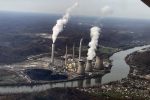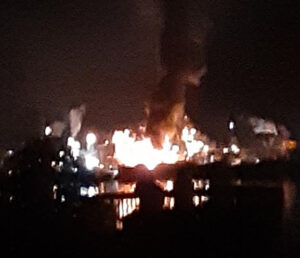Before you read this, please see this posting: Chemical Plants and Protecting Your Community: Speak Up to EPA
What Should I Talk About
- Share an example of an incident that has affected you or your community at a Risk Management Program (RMP) facility (such as a petroleum or oil refinery, chemical manufacturer, pulp/paper mill). Incidents during the last 1-4 years are especially helpful to share information on.
- Discuss environmental justice concerns caused by EPA’s inadequate regulation of industrial facility safety, and by the Trump EPA’s rollback of the Chemical Disaster Rule.
- Emphasize one or more key policy solutions that you believe are essential to include in a new, stronger rule.
- Provide new data or information, photos, or stories — especially from the last 2-5 years — that you think is helpful for EPA to consider as it is deciding how to strengthen these rules. And if you are sharing data, please also submit to the docket as a written comment after the session.
- Please speak from your personal or organization’s experience and expertise, and listen to and speak in solidarity with other groups affected by chemical disasters.
Key Issues and Potential Policy Solutions
Environmental Justice – EPA wants to hear about disproportionate impacts for communities, including communities burdened by more than one hazardous chemical facility. Please share information from your community on environmental injustice and how EPA’s new rule needs to address this. Are hazardous chemical facilities concentrated in your neighborhood? How many? How does this affect your community and your life?
Chemical disasters and risks made worse by climate change and natural disasters (“natech” incidents). EPA’s wants to hear about climate risks. Please share information from your community on incidents like fires, explosions, toxic releases, or near misses that you believe were made worse by hurricanes, high winds, floods, wildfires, other extreme weather. Please share any information on the natural disaster risks or threats in your area that you are concerned about because hazardous chemical facilities are located in areas at higher risk of natural disasters– including those made worse by climate as well as earthquakes and any other “natech” or double disaster risks (natural + technological risks, see the Arkema report for information). Please consider methods you believe would improve safety by ensuring facilities prepare more effectively for these incidents – like reducing hazards, using back-up power, changing facility design and systems to be safer, less hazardous startup & shutdown during or after natural disasters, fenceline monitoring, advance community notification for people living in an area with one or more chemical facilities, involving workers in planning and safety preparation.
Disaster prevention measures. EPA’s rules must prevent incidents – by reducing the hazards that can cause disasters to workers and communities in case of accidental release, by implementing preventative safeguards like safer technologies, chemicals, and processes, and expanding public access to information on these methods. EPA should restore the disaster prevention measures included in the 2017 amendments to the program, also known as the “Chemical Disaster Rule” – to ensure that workers and communities are protected and the environment remains clean and safe – and strengthen them. EPA should follow examples from California, Contra Costa, and New Jersey, using best available information. Examples – safer technology alternatives analyses (expanded to more facilities and strengthened) third-party audits, root cause and near miss analyses, decommissioning information, worker training and information.
Incident management and emergency response. EPA must include rules that reduce harm to communities, workers, and first-responders, in the event of an incident. For example – clear compliance deadlines for emergency response exercises, more information to first-responders, fenceline air quality monitoring, back-up power, multilingual alerts, advance community notification before an incident occurs to provide information to the public about nearby facilities and plan for emergencies.
Compliance design and enforceability. EPA must improve implementation and corrective action, (e.g., through strengthening the rule that covers the permitting of major Clean Air Act sources (40 CFR 68.215) to fully incorporate the RMP plans as an applicable requirement into permits, and through requiring more reports to EPA that are publicly accessible). EPA must strengthen worker participation, and provide for anonymous near-miss reporting to EPA, and encourage workers to take action to protect safety and avoid incidents. Ensure fast compliance deadlines for all requirements, and more reporting to EPA on compliance.
EPA must expand coverage of the rules and the RMP program to more facilities. For example: facilities using hazardous chemicals like ammonium nitrate and other reactives are not Yet there are huge risks from ammonium nitrate. In 2013 in Texas, where a fertilizer company storing ammonium nitrate exploded, leveling some 80 homes and a middle school. In all, 15 were killed, and about 200 injured. Thresholds for coverage must be reduced, and any facility covered in part by the rule must meet the regulations for the entire facility.
Sign Up
Session 1:
June 16, 2021, 12:00 – 4:00 PM EST
Registration link
Deadline to pre-register: June 14*
Session 2:
July 8, 2021, 4:00 – 8:00 PM EST
Registration link
Deadline to pre-register: July 6*
To sign up to offer a 3-minute statement during the session: At the link, on the drop-down menu of the question “Please select your desired method of participation” choose: “Provide live oral testimony.”
* If you cannot sign up in advance, please click the link to get the information on how to join the session, and you should be allowed to speak, if time allows.
Please join and speak for 3 minutes (and then you can leave or you are welcome to observe the entire session).
Translation and accommodations are available. Please sign up early for this, and indicate this in the registration form.
Why is EPA Holding These Sessions?
EPA is seeking comments and information from the public on potential areas of reform to the current RMP rule. These comments will help guide EPA as it considers what action to take next.
This is an area where the Obama EPA made progress – and then the Trump EPA went backward on health and safety. In 2017, EPA published a final rule, “Accidental Release Prevention Requirements: Risk Management Programs Under the Clean Air Act,” known as the Chemical Disaster Rule (2017 Rule). The rule included several provisions to protect worker and community safety from storage, use, and accidental release of hazardous substances at industrial facilities. One of the most significant requirements of this Rule was to consider “inherently safer technologies” that can fundamentally reduce the amount of hazardous substances used and the risk of potential harm from accidental release. The rule was set to be effective on March 14, 2017, later further delayed to June 19, 2017. The 2017 Rule went into effect after a court ruling in 2018, but EPA then rescinded all of the prevention measures in that rule on December 19, 2019. (2019 Rollback Rule). The 2019 Trump Rollback Rule removed many of the provisions that the 2017 Rule contained, including, most significantly, the inherently safer technology requirement, worker training, and more.
Under What Authority is EPA Reviewing the Risk Management Program?
EPA is acting under Clean Air Act section 112(r)(7), which is part of what is sometimes called the “Bhopal provision,” because it was enacted in 1990 to prevent a similar catastrophe in the United States. EPA is reviewing the rules in accordance with the Biden-Harris administration’s priorities, as discussed in Executive Order 13990. This Order, executed by President Biden on January 20, 2021, elevates to national priority worker safety and protection of community health and the environment. The Order calls for “immediate review” of all agency actions taken between January 20, 2017 and January 20, 2021 that threaten national commitment to public health and the environment.
If EPA Strengthens the Rules, How Soon Will We See New Protection?
If EPA recognizes the need to issue a stronger new rule, EPA will first issue a proposed rule for formal public review and comment. That proposal would provide detail on any changes that EPA proposes to make to the rules that hazardous chemical facilities must follow. After considering public comment, EPA will issue a final rule with compliance deadlines that will require action from hazardous chemical facilities. EPA’s timing is unclear. EPA should move as quickly as possible to bring stronger protection to your community. It is important for facilities to have to comply quickly – so communities and workers do not have to wait years for full implementation of the new rule.
What if EPA Does Not Issue a New Rule?
Then the harmful Trump Rollback Rule would remain in effect, and communities, workers, and first responders would continue facing serious chemical disasters without the health and safety protection promised by the law. This outcome would be shocking and would represent a fundamental failure to fulfill President Biden’s and Administrator Regan’s commitments to environmental justice, public health, and worker safety.
I’ve Never Spoken at an EPA Listening Session Before – What is it Like?
- This will be very informal and you will have the floor to speak for 3 minutes. EPA staff will listen carefully to what you say and will take this information into its rulemaking process.
- The listening session will be virtual so you can join from anywhere. Please turn your video on and make sure your sound works, so EPA can see and hear you.
- The listening sessions are open to the public so anyone can join and speak, and press may also cover the sessions by observing.
- Here is an example of a past public hearing so you can see the kind of testimony that speakers gave, to oppose the Trump rollback rule in 2018: https://www.regulations.gov/document/EPA-HQ-OEM-2015-0725-0985.
I Testified Before on the Issue of Chemical Disasters, Why Should I Speak Again?
- This is a new rulemaking process with the new administration. It is important to make your voice heard and ensure that EPA has the most up-to-date information from your community.
- The new administration needs to hear that you care about this significant environmental justice rule and that you want to see the strongest possible new rule from Administrator Regan and President Biden.
- These sessions are an essential time to influence EPA’s proposed rule – to provide up-to-date information on the need for safety and chemical disaster prevention measures, and to provide information on environmental justice and policy solutions.
- These sessions will be on the record, transcribed, and going into the public docket.
- Press will likely attend and watch these sessions – and it is important for them to hear from people concerned about chemical disasters about your real life experiences and concerns – and what it is like to live near facilities that can or often do explode, catch fire, or release dangerous toxic chemical plumes.
- These are also important opportunities to invite your organizational members, local fire chiefs, first responders and health professionals, and other allies locally and nationally to join and stand in solidarity with you and the coalition. Please think of members and allies whom you’ve worked with on this issue, or who are newly engaging on this issue, and ask them to sign up for these sessions as soon as possible, to help more new voices engage on this issue.
- It is possible to speak at one session, and join to watch and observe the other. Please feel free to attend both if you’d like to observe both. However, please sign up to speak at only one session – you do not need to speak at both, as EPA will be keeping records of each session.
More Information
History of the RMP Rule:
- Final Amendments to the Risk Management Program (RMP) Rule (2017), EPA: https://www.epa.gov/rmp/final-amendments-risk-management-program-rmp-rule
- Trump Administration’s Rollback of Chemical Disaster Rule Threatens Communities, First Responders, Sierra (Aug. 16, 2020), https://www.sierraclub.org/sierra/trump-administration-s-rollback-chemical-disaster-rule-threatens-communities-first-responders
- Coalition to Prevent Chemical Disasters, https://preventchemicaldisasters.org/
- A Disaster In The Making, https://earthjustice.org/features/toxic-catastrophes-texas-national-chemical-disaster-rule
- Earthjustice Case Page on Chemical Disasters: https://earthjustice.org/cases/2017/defending-community-safety-protections-from-chemical-disasters
- 2018 comment to EPA by EJHA, AAH, et al.: https://earthjustice.org/sites/default/files/files/Comments%20%28final%29_08-23-2018.pdf
- Chemical Disaster Rule and Rollback Rule docket containing comments and information: https://www.regulations.gov/docket/EPA-HQ-OEM-2015-0725
Rules:
- 2017 Rule: https://www.govinfo.gov/content/pkg/CFR-2017-title40-vol17/pdf/CFR-2017-title40-vol17-part68.pdf
- Federal Register Final Rule: https://www.govinfo.gov/content/pkg/FR-2017-01-13/pdf/2016-31426.pdf
- 2019 Rule: https://www.govinfo.gov/content/pkg/CFR-2019-title40-vol17/pdf/CFR-2019-title40-vol17-part68.pdf
- Federal Register Final Rule:https://www.govinfo.gov/content/pkg/FR-2019-12-19/pdf/2019-25974.pdf
CSB Information and Recommendations:
- Arkema, Inc. Chemical Plant Fire, https://www.csb.gov/arkema-inc-chemical-plant-fire-/
- https://www.csb.gov/investigations/
Examples of state and local rules that are stronger than EPA’s RMP
California Accidental Release Prevention (Cal ARP) Program for refineries
https://cchealth.org/hazmat/calarp/calarp4.php
Contra Costa Industrial Safety Ordinance
https://cchealth.org/hazmat/iso/
New Jersey Toxic Catastrophe Prevention Act Program
https://www.nj.gov/dep/rules/rules/njac7_31.pdf
Photo in sidebar of Belle, WV chemical plant explosion (December 8, 2020) courtesy of Melissa Smoot.












